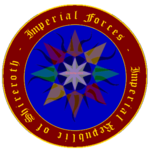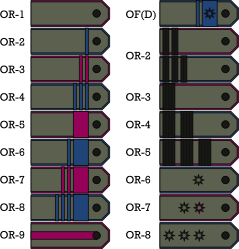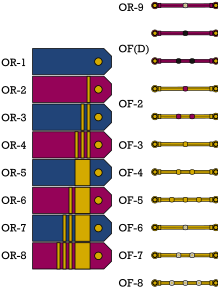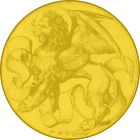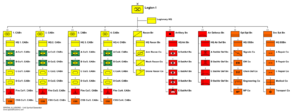Imperial Forces
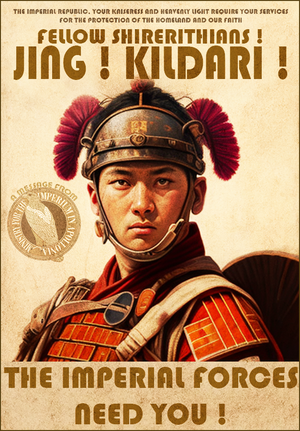

|
|||
| Active: |
| ||
| Motto: | Spite is our armour. | ||
| In use by: | Ministry of State | ||
| Allegiance: | Shireroth | ||
|
| |||
| Type: | Unified armed forces | ||
| Service Branches | |||
| Size: |
| ||
| Nickname: | The Forlorn Guard | ||
| Minister of Military Affairs: | The Admirable Zhao Feng, Lord of Nangang | ||
|
| |||
| Allies: | |||
| Opponents: | |||
| Conflicts & Deployments |
|
||
The Imperial Forces is composed of several military branches, namely the Imperial Army (these days a continuation and expansion of the original Palatini Corps), the Imperial Navy of Shireroth (INS), the Imperial Shirerithian Air Forces (ISAF), the Ordo Imperiale Decimae, the Shirerithian Supplies Service and Auxiliary Forces. The nation itself is divided in several military regions, called Departments. Untill the early 18th century, the Forces closely worked together with the Raspur Pact. Disagreements and potential departure from the Pact, led to hostile actions taken under the leadership of the Benacian Union against to retrieve military assets. Ever since the First Thuylemans Government, the Forces have been preparing for a potential conflict with its neighbour, which has been seen increasingly as a threat to Shirerithian sovereignty.
Recent History
Feudal Armies
The Imperial Forces of Shireroth were once a mighty military force, consisting of three main branches: the Imperial Army, the Imperial Navy of Shireroth (INS), and the Imperial Shirerithian Air Forces (ISAF). With a large population and vast territory, Shireroth was able to boast one of the largest and most powerful armies on Micras during the 16th and 17th centuries. However, the effectiveness of the Imperial Forces was hampered by their reliance on the support of local lords and their feudal armies. Despite their impressive size on paper, internal conflicts and competition for resources made them less formidable in reality. In fact, one of the grievances of the Kildari during the Revolution of 1617 was the lack of faith they had in the ability of the Kaiser and his Imperial Forces to defend the borders against invasions, such as that of the Garllicians.
In the 17th century, the Shirerithian Supplies Service became increasingly important, providing essential logistical support and acting as a reserve of paramilitary militia. However, the Kalirion Fracture devastated the Imperial Forces, reducing them to a small remnant of their former strength. The Palatini Corps emerged as a replacement for the Imperial Army, but this allowed for an opportunity to reform and modernize the remaining forces.
Raspur Pact Training Mission-Shireroth
The Raspur Pact Training Mission-Shireroth (RPTM-S) was established in 1679 at the initiative of Benacia Command. The aim of RPTM-S was to assist in the development of Imperial Forces training structures and institutions so that Shireroth could build an effective and sustainable capability that addressed the needs of the Imperial Republic, that would defend its remaining territories against secessionists and which would be able to resist any further efforts at capitulation by the regency in Shirekeep. RPTM-S was not a combat mission but was a distinct mission, under the political control of the Raspur Pact's Joint Military Council. Its operational emphasis was on training and mentoring. The activities of the mission were coordinated with the Shirerithian Ministry of State, whose minister was the de-facto commander of the Imperial Forces, and the Imperial Advisory Council.
In 1694 Benacia Command authorised the return of a significant quantity of surplus small arms, rejected by the UDF for use in the Second Elwynnese Civil War, to the arsenals of the Imperial Republic. These comprising primarily of:
- 243,838x – M1591 7.62 mm rifles
- 110,750x – M1656 9 mm sub-machine gun
- 80,000x – M1525 9 mm pistols
- 79,188x – M1508 Martini-Rossi 11.56 mm rifles
The weapons would be transferred from the depots of the Black Legions in the Unified Governorates to designated arsenals in Brookshire and the Duchy of the Guttuli via a series of road convoys that would travel across the UGB, Tellia, Sanama, and Drak-Modan in order to reach their intended destinations.
Salomeid Reforms
The early 18th century saw a shift towards a more modern approach to warfare, with new equipment, command structures, and organizational strategies being implemented. Many noble armies were disbanded and integrated into the revamped Imperial Forces, including those of Batavia and Jingdao.
Structure
The Imperial Forces have a distributed structure that relies predominantly on ground combat as a consequence of the Kalirion Fracture and the loss of advanced military hardware and the trained personnel to operate them. At its low point, the Palatini Corps was the only armed force under Imperial authority. One of the goals of the Thuylemans Cabinets has been to transform the many various semi-compatible organizations along a more streamlined, Imperium-wide plan.
Organizations
- Palatini Corps: ground, air, and riverine combat command headquartered in Shirekeep. Founded in 1637 AN, made independent in 1664 AN.
- The Sentinel Guards: ground combat formation
- The Secret Guards: ground combat formation
- The Palace Guards: ground combat formation
- The Kampioen Guards: ground combat formation
- The Apollonian Guards: ground combat formation
- The Veteran Guards: ground combat formation
- The Kalirion Guards: ground combat formation
- The Sathrati Guards: ground combat formation
- The Flying Guards: aerial combat formation
- Evagati Corps
- Ducal Army of Brookshire: ground combat command headquartered in Maltenstein. Organized in 1683 AN as Her Imperial Highness's Brookshirian Auxiliary Service and regional militia, reorganized in 1695 AN.
- Dolorous Association: ground combat formation
- Isenbury Association: ground combat formation
- Woodshire Association: ground combat formation
- Ducal Army of the Guttuli: ground and maritime combat command headquartered in Lachlan. Organized in 1694 AN from preexisting local peacekeeping forces.
- Lockenhasp Association: ground combat formation
- Lowbrook Association: ground combat formation
- Ducal Army of Modan: ground combat command headquartered in Drakorda. Organized in 1704 AN from the anti-SCROTUM elements of the Drak-Modani Defense Force
- Mortis Mercatoria Association: ground combat formation
- Keizerlijke en Koninklijke Strijdkrachten van Batavië
- Leeuwenkorps
- Vrije Weermacht
- Bataafse Koninklijke Luchtmacht
- Bataafse Koninklijke Zeemacht
- Imperial Navy of Shireroth
- The River Guards: riverine combat formation (administered by the Palatini Corps)
- 1st Maritime Association: headquartered in Lichport, organized in 1690 AN as the Sea Corps (administered by the Ducal Army of the Guttuli)
- 2nd Maritime Association: headquartered in Eriksburg (administered by the Ducal Army of Modan)
- 3rd Maritime Association: headquartered in Fort Sephiroth (administered by the Ducal Army of Modan)
- So-Saran Battle Command: combined-arms air-ground naval infantry formation
- Draconian Battle Command: combined-arms air-ground naval infantry formation
At the operational level, ground combat units are organized into Reinforced Cohorts (Pr. Toißuszoþ Gauht), a concept adapted from the Guttuli Corps's Streïkrupp. As the name suggests, an infantry cohort is reinforced with attached armored reconnaissance, artillery, and engineering maniples. This allows for the application of heavy weapons systems to be more easily available at the tactical level. The commanding officer of the cohort, typically a Mid-Grade Tribune, serves as the commanding officer for the Reinforced Cohort.
Three Reinforced Cohorts, along with the parent units for their attached combat support as well as additional defensive and logistical support units, are organized into a Battle Command. The Battle Command is expected to be capable of sustained independent operations.
Departments
Implemented in 1724 AN, the Imperium is divided into a series of regional military districts, or Departments, to control and administer military installations and units located within their jurisdiction. Regular transfers between the various departments over the next few years allowed for units with vastly different origins and operating principles to learn and train together.
| Name | Headquarters | Region |
|---|---|---|
| Department of the West | Macoeur | Batavia, Sagittarius, Faya Veronique Island, Dietsberg |
| Department of the Confluence | Lichkeep | Shirekeep, Woodshire, Maltenstein |
| Department of the Gaudin | Rhodondra | Highpass, Schwinn, Dolorous, Shimmerspring, Thanatos, Sehmls |
| Department of the Isen | Dalbruï | Fortis, Isenbury, Lakhal, Dragacht, Aquaraqua, Skyla Islands |
| Department of the Guttuli | Irenaea | Near Guttuli, Far Guttuli, Coastal Guttuli, Lichport |
| Department of MASS | Arg-e Isabella | So-Sara, Zy-Rodun, Draconia, Amity, Mirioth, Yardistan |
| Department of the East | Port Halluci | Kezan, Dalmacija, Qaoshan, Kildare, Jingdao, Blackrock, Gong Li, Audentior, Jinkeai, Xianbei, Talenore |
Ranks
As directed by the Ministry of State's Commission for Defence, regular Imperial Forces now operate within a single system of ranks, uniforms, and equipment, in order to sustain interoperability.
On paper, each regional army maintains its own general staff under the authority of its own Master of Soldiers, who creates field formations, called Associations, over whom he designates a Standard. In actuality, the regional armies have been reduced to a merely administrative role, with each general staff tasked with maintaining supply and training. Associations are created under the direction of, under the authority of an appointee of, and receive strategic direction from the Commissioner for Defence. Associations are composed of units freely shuffled between Associations as necessary to meet Imperial strategic goals with the shortest logistical lines. This arrangement is a systematized form of the previous ad-hoc Banners placed under the appointed authority of a Nypḥyk'u (RL. "Standard Bearer"), whose subordinate units were a free mixture of militia, professional, and irregular troops as resources allowed it.
These changes are reflected in the changes to the rank structure, which no longer distinguishes between 'Spear' and 'Specialist' units, which has condensed the general officer ranks considerably, which has placed significantly larger responsibility upon the Field Officer ranks, and which has seen an expansion of Company-Grade and senior-NCO ranks. Under this new scheme, which has been influenced by its roots in the Brookshire militia and re-educated remnants of the Guttuli Corps, NCOs (or Principals) can seek entry into the Officer Candidate program, receive a commission, and gain access to the higher ranks. The children of nobles have adjusted to this more meritocratic officer recruitment process by sending their children into military academies, so that they may qualify for career acceleration upon entry into the Imperial Forces.
| Rank | Ground Force | Air Force | Maritime Force | |||||
|---|---|---|---|---|---|---|---|---|
| General Officer |
OF-8 | Master of Soldiers / Frainan Streïakeï | Army, CO | |||||
| OF-7 | Standard / Staggus | Association, CO | ||||||
| Field Officer |
OF-5 | Tribune (Broad Grade) / Ahmst (Bræþ Griþ) | Battle Command, CO | Squadron, CO | ||||
| OF-4 | Tribune (Mid Grade) / Ahmst (Mi Griþ) | Cohort, CO | Wing, CO | Frigate, CO | ||||
| OF-3 | Tribune (Narrow Grade) / Ahmst (Mair Griþ) | Cohort, 2i/c | Group, CO | Corvette/Submarine, CO | ||||
| Company Officer |
OF-2 | Captain / Fiþnan | Ordinate / Opratzan | OR-9 | Principal | Maniple, OC | Chain, CO | |
| Undercaptain / Niþnfiþnan | First Overwatchmaster / Ænst Uvnahtaldan | OR-8 | Maniple, 2i/c | |||||
| OF(D) | Overwatchmaster-Squire / Uvnahtaldan-Silbir | Overwatchmaster / Uvnahtaldan | OR-7 | Watch, OC | ||||
| Watchmaster-Squire / Ahtaldan-Silbir | Watchmaster / Ahtaldan | OR-6 | ||||||
| Underwatchmaster / Niþnahtaldan | OR-5 | Watch, 2i/c | ||||||
| Prime / Frum | OR-4 | Soldier | File, OC | |||||
| Chosen / Usczosoþ | OR-3 | File, 2i/c | ||||||
| Experienced / Usfaroþ | OR-2 | |||||||
| New / Nuï | OR-1 | |||||||
Specialists
After two years of their initial contract, soldiers may apply for specialist training. If accepted, they become a Trainee Specialist under the apprenticeship of a Principal Specialist. Following apprenticeship, certification is required for being assigned a specialist billet. Principal Specialists combine skills specialization with the tasks of organic leadership, discipline, and training.
Entry into a military academy grants certified specialist status upon completion. The most common military academy is an Officer Candidate School, and is required for receiving an officer commission.
| Command & Discipline | Artillery | Combat Support | Administrative | Medical | Engineering | |
|---|---|---|---|---|---|---|
| OF-2 |
|
Battery OC | Physician | Engineer | ||
| Maniple 2i/c | Battery 2i/c | Assistant Physician | Assistant Engineer | |||
| OR-9 | Maniple OC | Battery OC | Medical Ordinary | Architectural Ordinary | ||
| OR-8 | Maniple 2i/c |
|
||||
| OR-7 | Watch OC |
|
Forward Observer |
|
Medical Vulnerary |
|
| OR-6 | ||||||
| OR-5 | Watch 2i/c | |||||
| OR-4 | File OC | Artillerist |
|
|
Medic |
|
Term of Service
Soldiers join the Imperial Forces under an initial 6-year contract. After completing their initial contract, if they pass qualifications, they may be offered a second 4-year contract as a Junior Principal. Thereafter, if they pass qualifications, they may be offered a third long-term contract as a Senior Principal.
Soldiers may be up-contracted before their initial contract has been completed if they are highly qualified, highly specialized, or are certified to fill a role that is in particularly high demand.
Upon honorable completion of service, an individual is awarded with perpetual status under Grade A and a medallion of service completion, so that denizens without merit may know they are legally obliged to provide a demonstration of respect. Failure to maintain dignity of status may result in revocation one's Grade A status and the destruction of one's medallion.
Uniforms
In the decades after the Kalirion Fracture, the Imperium relied upon irregular forces, local militia, and rehabilitated defeated hostile forces to augment the Palatini Corps, the only components of Benacia Command that had remained loyal to the Golden Mango Throne. Beginning in the 1690s, regularization became a priority for the Imperial Commission for Defence. Introduced in 1702 AN, a new set of standardized uniform specifications were established, replacing all previous forms.
The Palatini Corps retained a distinct color and cut for its field and service uniforms, and was given permission to continue using its distinct Full Dress uniform, first authorized in 1663 AN, when on ceremonial duty in Shirekeep.
Field Dress
Issued to all members of the Imperial Forces, derived from the all-weather utility uniform used by the Ŝḥenĉeł'yh and adopted by the Brookshire Ducal Army.
Service Dress
Distinct variants for Officers and Principals. Service Dress for Officers and Ordinates is modelled on the pre-Fracture Lancer officer tunic, now applied to all officers irrespective of unit type. Service Dress for other Principals uses the same design as the Field Dress uniform but out of the same fabric and dyes as the Service Dress for Officers. Soldiers are not issued a Service Dress uniform, but may purchase it for non-field duty use when authorized by their commanding officer (e.g. ceremonial duty, parade, court appearance, public-facing offices, etc).
Noteworthy Insignia
Equipment
Aircraft
- See Imperial_Shirerithian_Air_Forces#Equipment for a list of equipment.
Artillery
| Name | Origin | Type | № in Service | Image | Notes |
|---|---|---|---|---|---|
| Anti-aircraft artillery | |||||
| ALB (Anti-Air Gun) | Self-propelled anti-aircraft gun | 420 | Four 30mm autocannons in pairs (2000 rounds) | ||
| Ikari 2A SPAAG | Self-propelled anti-aircraft gun | 405 | 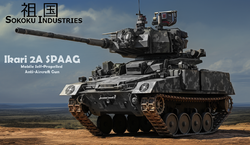 |
||
| SAI RAPIER | Short-range air defence system | 204 | 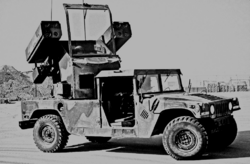 |
| |
| Field artillery | |||||
| 80 mm field gun | Towed artillery | 380 | 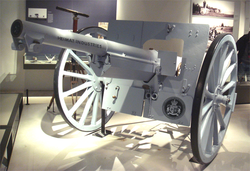 |
Rebuilt and returned to service. | |
| Apollo HA-IX | Self-propelled artillery | 134 | 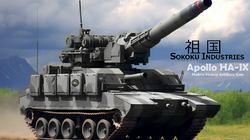 |
||
| RB (Mobile Gun) | Self-propelled gun | 497 |
| ||
| SAI MGW1 155 | Self-propelled howitzer | 1,170 | 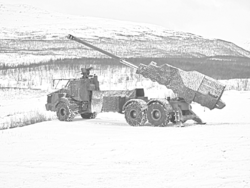 |
| |
Infantry equipment and weaponry
Equipment for the infantry, much of it obsolete and dating back to before the Kalirion Fracture, had been much plundered by the Black Legions and Benacia Command. These losses were made by acquisitions from companies in Batavia, Kildare, and Sanama.
| Name | Origin | Type | № in Service | Image | Notes |
|---|---|---|---|---|---|
| Equipment | |||||
| Personal weapons | |||||
| Clock 19 |
|
194,824 | 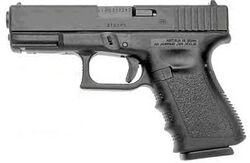 |
||
| M1525 9 mm pistol |
|
75,950 | 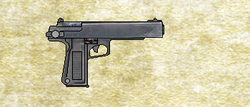 |
||
| M1591 rifle | Marksman rifle | 25,200 | |||
| M1610 7.9 mm rifle (semi-automatic) | Service rifle (obsolete) | 47,705 | 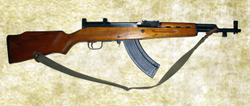 |
||
| M1656 9 mm submachine-gun |
|
158,725 | 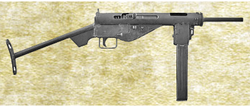 |
||
| OL Pattern M1718 | Battle rifle | 2,421,704 |  |
Primary service rifle for denizens attached to the Imperial Ground Forces as regulars. | |
| Section weapons | |||||
| AG-11 machine gun | Light machine-gun | ||||
| Troop weapons | |||||
| G19 machine gun | Heavy machine-gun | ||||
| Squadron weapons | |||||
| Protective equipment and body armour | |||||
Vehicles
| Name | Origin | Type | № in Service | Image | Notes |
|---|---|---|---|---|---|
| Armoured vehicles | |||||
| Horjin Combat Vehicle 56 | Infantry Fighting Vehicle | 4,905 |  |
||
| IMW-3 Snark | Mobile command platform | 295 | 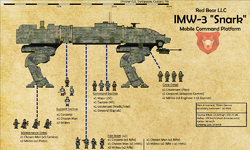 |
||
| J-23 Heavy Tank | Heavy tank | 2 | 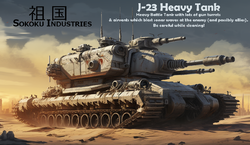 |
||
| Mango-H1 Tank | Heavy tank | 3,600 |  |
||
| Oni 1717 AFV | Armoured fighting vehicle | 1,486 / 4,900 |
| ||
| SG-1 Baker King | Armoured fighting vehicle | 1,071 / 2,667 | 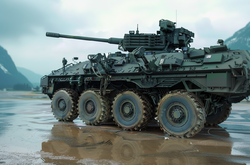 |
| |
| Sokoku Rec-1722B | Infantry mobility vehicle | 2,188 | |||
| Taiyo III | Light tank | 350 | File:Taiyo III.png | ||
| Taiyo IV | Light tank | 382 | File:Taiyo IV.png | ||
| Gravimetric vehicles | |||||
| FC-15 Stoat | Compact Armored Fighting Vehicle | 343 | |||
| Support vehicles | |||||
| IE-1 Goat | Light cargo tractor | 14,274 | |||
| SG-3 Halyard King | Modular combat support vehicle | 16,973 | |||
| Sokoku Rec-1722A | Scout vehicle | 1,043 | |||
Vessels
Late Salomeid Reforms (1710s & 1720s)
During the early 18th century, plans were forged to reform and modernize the weakened armed forces of the Imperial Republic.
Service branches:
- Imperial Ground Forces
- "Gaelen IV" Regiment: opposing force unit for training purposes
- Palatini Corps
- Corps of Auxiliaries
- Leftovers of the Jingdaoese Armed Forces
- Leftovers from the Batavian Royal Army
- Scholae Apollonae
- Imperial Maritime Forces
- Imperial Navy Fleet
- Imperial Navy Cadet Force
- Coastal Defence Guard
- Imperial Aerial Forces
- Air Support Command
- Air Defence Command
- Bomber Command
- Fighter Command
- Strike Command
- Luchtmobiele Brigade
- Shirerithian Supplies Service
- Directorate of Imperial Defence Administration
- Directorate of Research & Engineering
- Intelligence and secret services
- Chamber of the Crypteia
- Tegong: religious and cultural police
- Ordo Imperiale Decimae & Vigiles Arcani
- S.W.O.R.D.
- Strategic Defence Initiative: defence of the air space and territory of the Imperial Republic against attack by ballistic missiles or other weapons of mass destruction by external forces
Imperial Ground Forces
The primary service branch of the Imperial Forces, the Imperial Ground Forces shall be organized into Corps (Pr. Uihmanz). Each Corps shall have the following organic divisions:
- Artillery
- Air Defence
- Aviation
- Operational Support
- Service Support
- Special Operations
To each combat-ready Corps, there shall be deployed six Legions (Pr. Salb). Legions shall be graded according to their combat role:
- Heavy: armored combined-arms
- Medium: reinforced mechanized infantry
- Light: motorized infantry
- Amphibious: amphibious mechanized infantry
- Air Assault: reinforced helicopter-dropped infantry
- Mountain: light infantry with special training and equipment for high-altitude combat environment
Additionally, legions identified with the honorary of Palatini were granted permission to wear uniform variants associated with the Palatini Corps (from whom the new Palatini Legions were derived), as well as the honor of being recruitment pools for ceremonial duty and/or for life guard duty to protect members of the Imperial Family.
On 1.I.1728, the first such corps, called 1. Corps, was stood up and assigned to the Department of the Confluence. It drew soldiers and equipment from the Palatini Corps, Ducal Army of Brookshire, and the Feudatory Host of Kildare.
Legionary Index
| Legion | Assigned to Corps | Department Deployed To | Grade | Honorary | Composed From… |
|---|---|---|---|---|---|
| 1. Legion | 1. Corps | Confluence | Heavy | Palatini | Ahtaneï (4) |
| 2. Legion | 1. Corps | Confluence | Medium | Palatini | Ahtaneï (3), Bivarhinseï (1) |
| 3. Legion | 1. Corps | Confluence | Medium | Palatini | Ahtaneï (3), Bivarhinseï (1) |
| 4. Legion | 2. Corps | East | Heavy | Palatini | Darneï (4) |
| 5. Legion | 2. Corps | East | Medium | Palatini | Darneï (3), Bivarhinseï (1) |
| 6. Legion | 2. Corps | East | Medium | Palatini | Darneï (3), Bivarhinseï (1) |
| 7. Legion | 3. Corps | Confluence | Heavy | Palatini | Kampioeneï (4) |
| 8. Legion | 3. Corps | Confluence | Medium | Palatini | Kampioeneï (4) |
| 9. Legion | 3. Corps | Confluence | Medium | Palatini | Kampioeneï (2), Apollonseï (2) |
| 10. Legion | 4. Corps | West | Heavy | Palatini | Apollonseï (4) |
| 11. Legion | 4. Corps | West | Medium | Palatini | Apollonseï (4) |
| 12. Legion | 4. Corps | West | Medium | Palatini | Ripoþeï (4) |
| 13. Legion | 5. Corps | Confluence | Heavy | Palatini | Ripoþeï (4) |
| 14. Legion | 5. Corps | Confluence | Medium | Palatini | Kalirseï (4) |
| 15. Legion | 5. Corps | Confluence | Amphibious | Palatini | Kalirseï (2), Łodseï (2) |
| 16. Legion | 6. Corps | Guttuli | Heavy | Palatini | Kalirseï (4) |
| 17. Legion | 6. Corps | Guttuli | Medium | Palatini | Saþratiseï (4) |
| 18. Legion | 6. Corps | Guttuli | Medium | Palatini | Ripoþeï (2), Saþratiseï (2) |
| 19. Legion | 7. Corps | Isen | Heavy | Palatini | Saþratiseï (4) |
| 20. Legion | 7. Corps | Isen | Heavy | Palatini | Bivarhinseï (2), Łodseï (2) |
| 21. Legion | 7. Corps | Isen | Amphibious | Palatini | Łodseï (4) |
| 22. Legion | 8. Corps | East | Medium | Palatini | I Banner Army |
| 23. Legion | 9. Corps | East | Medium | Palatini | II Banner Army |
| 24. Legion | 10. Corps | East | Medium | Palatini | III Banner Army |
| 25. Legion | 11. Corps | East | Medium | Palatini | IV Banner Army |
| 26. Legion | 12. Corps | East | Heavy | Palatini | V Banner Army |
| 27. Legion | 13. Corps | West | Medium | Palatini | Leeuwenbrigade |
| 28. Legion | 14. Corps | West | Medium | Palatini | Leeuwenbrigade |
Deployment of Forces (circa 1730 AN)
- This list is incomplete. You can help by expanding it.
| Department of the West | 4. Corps |
|
|---|---|---|
| 13. Corps |
| |
| 14. Corps |
| |
| Department of the Confluence | 1. Corps |
|
| 3. Corps |
| |
| 5. Corps |
| |
| Department of the Gaudin | Ć'eleiedźak'o'azeho, 7re Dekošyre Ġuseš | |
| Department of the Isen | 7. Corps |
|
| Department of the Guttuli | 6. Corps |
|
| Department of MASS |
| |
| Department of the East | 2. Corps |
|
| 10. Corps |
| |
| 11. Corps |
| |
| In Transit | 8. Corps |
|
| 9. Corps |
| |
| 12. Corps |
|
